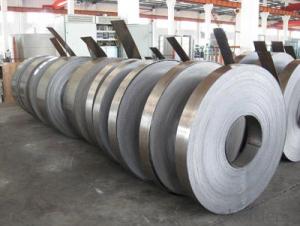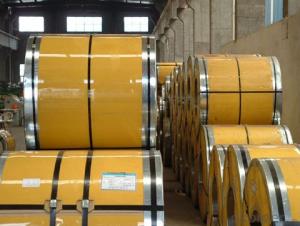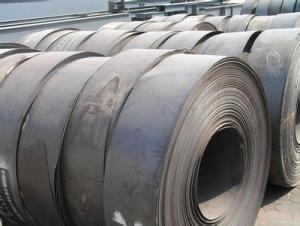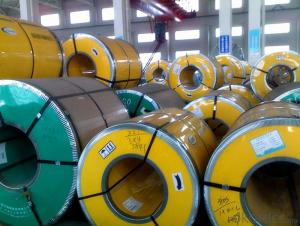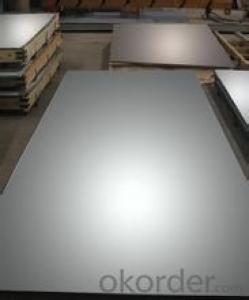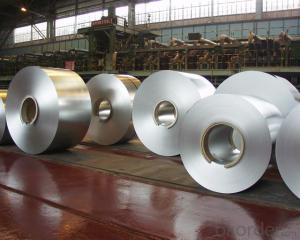Galvanized Steel Strip with High Quality-SGCC 680*1.0mm
- Loading Port:
- China main port
- Payment Terms:
- TT OR LC
- Min Order Qty:
- 50 m.t
- Supply Capability:
- 10000 m.t/month
OKorder Service Pledge
OKorder Financial Service
You Might Also Like
Galvanized Steel Strip with High Quality-SGCC 680*1.0mm
Product Description:
Specifications:
Thickness: 1.0mm
Width: 680mm
Material: SGCC
ID: 508mm or 610mm
Spangle: Regular spangle or zero spangle
others: chromated or no chromated; oiled or no oiled.
Advantages of Galvanized Steel Strip with High Quality-SGCC 680*1.0mm:
1. Uniform coating;
2. Strong adhesion;
3. Strong corrosion resistant ability
Usage of Galvanized Steel Strip with High Quality-SGCC 680*1.0mm:
1. Making pipes, like Greenhouse tubes, drinking water pipe, heating pipe, gas pipe and so on;
2. Used in automobile;
3. Used in construction;
4. Used in agriculture, fishery and so on.
FAQ of Galvanized Steel Strip with High Quality-SGCC 680*1.0mm:
Q1: How soon can we receive the product after purchasement?
A1: Within three days of placing an order, we will begin production. The specific shipping date is dependent upon international and government factors, but is typically one month-two months.
Q2: How do you guarantee the quality of our products?
A2: We have established an advanced quality management system which conducts strict quality tests at every step, from raw materials to the final product. At the same time, we provide extensive follow-up service assurances as required.
Q3: The prices are invoicing on theoritical weight or on actual weight?
A3: We can do it in both manners, according to the customers' request.
Images of Galvanized Steel Strip with High Quality-SGCC 680*1.0mm:
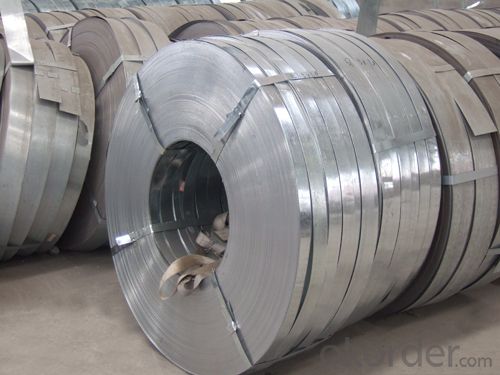
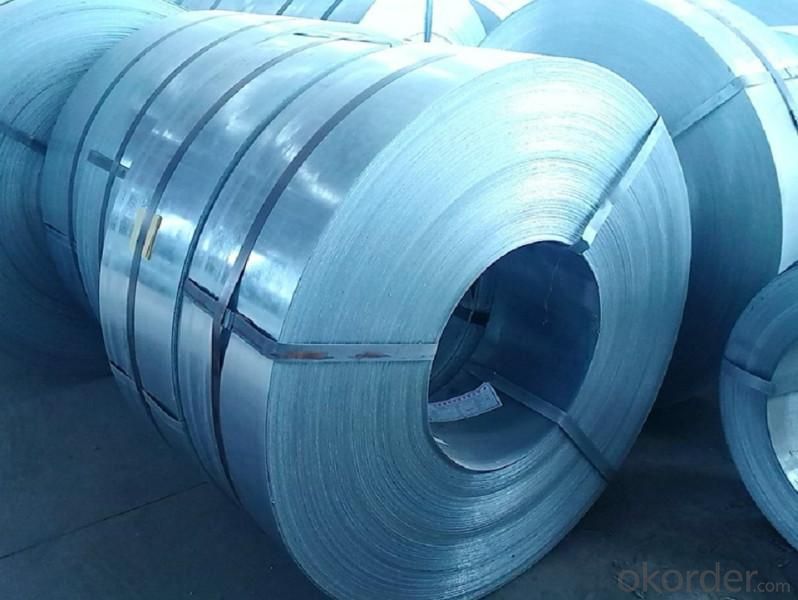
*If you would like to get our price, please kindly inform us the standard/material, specifications and quantity. Thank you very much for your attention.
- Q:Can steel strips be galvanized after being formed into a shape?
- Yes, steel strips can be galvanized after being formed into a shape. Galvanizing is a process in which a protective zinc coating is applied to steel to prevent it from rusting. This process can be done on steel strips that have been formed into complex shapes, such as tubes, angles, or channels. The steel strips are first cleaned to remove any dirt or impurities, and then they are immersed in a bath of molten zinc. The zinc adheres to the surface of the steel, forming a protective layer that acts as a barrier against corrosion. This galvanized coating can be applied to steel strips regardless of their shape, making it a versatile and effective method for protecting steel against rust.
- Q:How are steel strips measured for thickness?
- Steel strips are typically measured for thickness using specialized tools such as micrometers or thickness gauges. These instruments allow for accurate and precise measurements by exerting a controlled pressure on the strip and providing a digital or analog readout of its thickness.
- Q:Are steel strips used in the production of medical instruments?
- Steel strips are frequently employed in the manufacturing of medical instruments. They serve as a primary material for the production of diverse medical instruments, encompassing surgical tools, dental equipment, orthopedic implants, and diagnostic devices. The utilization of steel strips in medical instrument fabrication brings forth numerous beneficial characteristics, notably robustness, endurance, and resistance to corrosion. These attributes render steel strips an optimal selection, guaranteeing the durability and dependability of medical instruments, which are pivotal for both patient safety and efficient healthcare procedures.
- Q:How are steel strips used in the production of pipes?
- Steel strips are commonly used in the production of pipes as they serve as the primary material for manufacturing seamless and welded pipes. These strips are shaped into cylindrical tubes through processes such as bending, welding, and rolling. The steel strips provide the necessary strength and durability required for pipes to withstand high pressure and various environmental conditions, making them an essential component in pipe production.
- Q:What are the heat treatment options for steel strips?
- There are several heat treatment options available for steel strips, depending on the desired properties and applications. 1. Annealing: This process involves heating the steel strips to a specific temperature and then slowly cooling them, often in a controlled atmosphere. Annealing helps to relieve internal stress, improve ductility, and refine the microstructure of the steel. 2. Quenching and tempering: This two-step process involves heating the steel strips to a high temperature and then rapidly cooling them in a quenching medium, such as oil or water, to achieve high hardness. The strips are then tempered by reheating them to a lower temperature, which reduces brittleness and improves toughness. 3. Hardening: Hardening is a process used to increase the hardness and strength of steel strips. The strips are heated to a critical temperature and then rapidly cooled to achieve martensite, a hard and brittle phase. This process is commonly used for tool steels or applications requiring high wear resistance. 4. Case hardening: Case hardening is a surface treatment that involves adding a hard outer layer to the steel strips while maintaining a tough and ductile core. This is achieved by introducing carbon or nitrogen into the surface of the strips through processes like carburizing or nitriding. Case hardening improves wear resistance and fatigue strength. 5. Stress relieving: This process is used to remove residual stresses that may have formed during manufacturing or other heat treatment processes. The steel strips are heated to a temperature below the transformation range and then slowly cooled. Stress relieving helps to prevent distortion, cracking, and dimensional instability. These are just a few examples of the heat treatment options available for steel strips. The choice of treatment will depend on factors such as the desired mechanical properties, specific applications, and the type of steel being used. It is important to consult with metallurgical experts and follow specific guidelines to ensure the desired results are achieved.
- Q:How are steel strips processed for load-bearing capacity?
- Steel strips are processed for load-bearing capacity through various techniques such as heat treatment, cold rolling, and alloying. Heat treatment improves the steel's strength and hardness by subjecting it to controlled heating and cooling processes. Cold rolling reduces the thickness and increases the strength of steel strips by passing them through rollers at low temperatures. Alloying involves adding specific elements to steel to enhance its mechanical properties, such as increasing its resistance to corrosion or improving its ability to bear heavy loads.
- Q:What are the common grades of steel used for making strips?
- The common grades of steel used for making strips vary depending on the specific application and desired properties. However, some commonly used grades include: 1. Low carbon steel (C1008/C1010): This grade of steel is often used for making strips due to its excellent formability and weldability. It is commonly used in industries such as automotive, construction, and appliances. 2. Medium carbon steel (C1045/C1050): This grade of steel offers better strength and hardness compared to low carbon steel. It is often used in applications where higher strength and wear resistance are required, such as in the manufacturing of cutting tools or machinery parts. 3. High carbon steel (C1095): High carbon steel strips offer the highest strength and hardness among common grades. They are commonly used for making springs, saw blades, and other high-stress applications where durability and resilience are crucial. 4. Stainless steel (e.g., 304/316): Stainless steel strips are widely used due to their excellent corrosion resistance and aesthetic appeal. They are commonly used in applications such as kitchenware, automotive trims, and architectural components. 5. Alloy steel (e.g., 4140/4340): Alloy steel strips are made by adding various alloying elements to enhance specific properties such as strength, toughness, or heat resistance. They are commonly used in applications requiring high strength and durability, such as in the manufacturing of gears, shafts, or aerospace components. It is important to note that these are just a few examples of the common grades of steel used for making strips, and there are numerous other grades available, each with its own unique properties and applications. The selection of the appropriate grade depends on factors such as the intended use, required mechanical properties, and environmental conditions the strips will be exposed to.
- Q:How are steel strips processed for electrical conductivity?
- Various methods can be utilized to enhance the electrical conductivity of steel strips. One commonly employed technique is known as annealing, which entails subjecting the steel strip to a specific temperature and gradually cooling it down. By doing so, any impurities and internal stresses within the steel are eliminated, leading to an improvement in its electrical conductivity. Electroplating is another method adopted for this purpose. This method involves applying a layer of a more conductive material, such as copper or silver, onto the surface of the steel strip. The strip is submerged in an electrolyte solution, through which an electric current is passed. Consequently, the conductive material is deposited onto the steel strip's surface, thereby enhancing its electrical conductivity. Moreover, surface treatments like chemical etching or mechanical polishing can be employed to eradicate any surface impurities or oxides that may hinder electrical conductivity. These processes facilitate the creation of a clean and smooth surface, enabling a better flow of electrical current through the steel strip. In summary, the enhancement of steel strips' electrical conductivity necessitates the utilization of techniques such as annealing, electroplating, and surface treatments. These methods ensure that the material is suitable for electrical applications by improving its conductivity.
- Q:How are steel strips hardened and tempered?
- Steel strips are hardened and tempered through a specific heat treatment process. First, the steel strips are heated to a high temperature, known as the austenitizing temperature. This temperature allows the steel to transform into austenite, a phase with a face-centered cubic crystal structure. Once the steel strips have reached the austenitizing temperature, they are rapidly cooled through a process called quenching. Quenching involves immersing the steel strips in a medium such as oil, water, or polymer, which causes the austenite to transform into a hard, brittle phase called martensite. This rapid cooling ensures that the steel strips achieve maximum hardness. However, martensite is also extremely brittle and lacks toughness. To improve the toughness and reduce the brittleness of the steel strips, they undergo a tempering process. During tempering, the steel strips are reheated to a lower temperature, typically between 300-700 degrees Celsius. This heating allows the excess hardness in the martensite to be reduced, while also increasing the strength and toughness of the steel. The exact temperature and duration of the tempering process depend on the desired mechanical properties of the steel strips. Higher tempering temperatures result in lower hardness but increased toughness, while lower temperatures result in higher hardness but decreased toughness. Overall, the combination of hardening and tempering allows steel strips to achieve a balance between hardness and toughness, making them suitable for various applications such as manufacturing tools, springs, and structural components.
- Q:What are the different types of coatings available for steel strips?
- There are several types of coatings available for steel strips, including galvanized coatings, which provide corrosion resistance through a layer of zinc; organic coatings, which provide protection through paint or polymers; metallic coatings, such as aluminum or tin, which offer additional corrosion resistance; and phosphate coatings, which enhance adhesion and improve corrosion resistance.
1. Manufacturer Overview |
|
|---|---|
| Location | |
| Year Established | |
| Annual Output Value | |
| Main Markets | |
| Company Certifications | |
2. Manufacturer Certificates |
|
|---|---|
| a) Certification Name | |
| Range | |
| Reference | |
| Validity Period | |
3. Manufacturer Capability |
|
|---|---|
| a)Trade Capacity | |
| Nearest Port | |
| Export Percentage | |
| No.of Employees in Trade Department | |
| Language Spoken: | |
| b)Factory Information | |
| Factory Size: | |
| No. of Production Lines | |
| Contract Manufacturing | |
| Product Price Range | |
Send your message to us
Galvanized Steel Strip with High Quality-SGCC 680*1.0mm
- Loading Port:
- China main port
- Payment Terms:
- TT OR LC
- Min Order Qty:
- 50 m.t
- Supply Capability:
- 10000 m.t/month
OKorder Service Pledge
OKorder Financial Service
Similar products
New products
Hot products
Related keywords
